Parametric Oscillators and Amplifiers
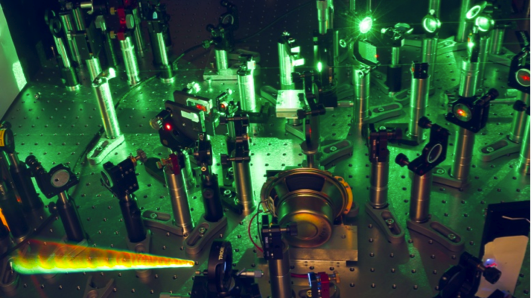
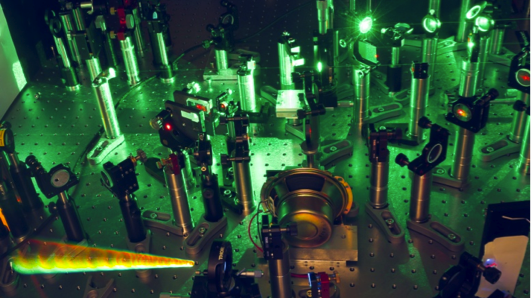
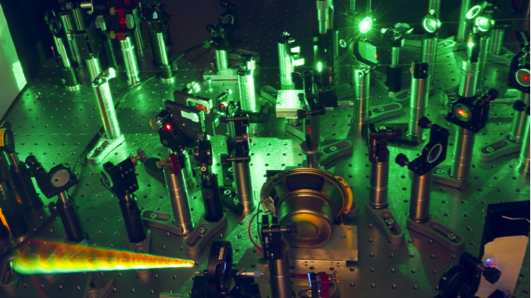
When the electric field in a laser pulse becomes comparable to the intra atom field strengths in matter, the electron motion becomes inharmonic, and nonlinear optical phenomena such as frequency doubling or sum- and difference frequency mixing can be observed. With high power ultrafast lasers these effects can be driven very efficiently, opening up the world of parametric oscillators and amplifiers as laser light sources with very special properties.
-
Noncollinear Parametric Oscillator (NOPO)
NOPO’s are light sources, covering an ultra wide and ultra fast tunability as well as the flexibility in spectral width from a narrowband to an ultra broadband spectrum. Our system is build up in a non-collinear configuration to support an ultra wide and fast tunability. Because of the power scalability of our system we are able to extract more than 3 W. A unique feature is the speed of tuning. We are able to ramp the center wavelength of the fs-light pulses with more than 100 000 nm/s.
![]()
![]()
![]()
-
OPCPA
The frond-end of our Optical Parametric Chirped Pulse Amplification (OPCPA) is a broadband, CEP stabilized Ti:sapphire oscillator, which delivers the seed for the parametric amplification and a small fraction at 1030 nm provides the seed for a homebuilt regenerative amplifier.
With a double-stage NOPA setup, where both pump frequencies are the SHG of 1030 nm, we mesured two-cycle pulses with sub 6 fs of pulse duration and more than 5 µJ of pulse energy at 200 kHz.
A double-stage NOPA pumped with the SHG and the THG of 1030 nm, delivers 1 µJ at 200 kHz with a spectrum spanning from 430 nm to 1.3 µm supporting an almost single-cycle pulse. We measured pulse durations of sub 5 fs using a broadband double chirped mirror pair for pulse compressing of a part of the whole output spectrum.
![]()
![]()
![]()
-
Non-Collinear Optical Parametric Amplifier (NOPA)
The non-collinear optical parametric amplifier (NOPA) in our lab delivers sub-10-fs pulses with 420 nJ of pulse energy. The NOPA is driven by microjoule pulses from an home-build Yb:KYW oscillator with cavity-dumping and a subsequent single-stage rod-type fiber amplifier at 1-MHz repetition rate. The ultrabroad-band seed is based on stable white-light generation from 420 fs long pulses in a YAG plate. This system is used for different applications like two-photon-polymerization (2PP) , CARS and OCT.
![]()
![]()
![]()
Ultrafast Solid State-Oscillators and Amplifiers
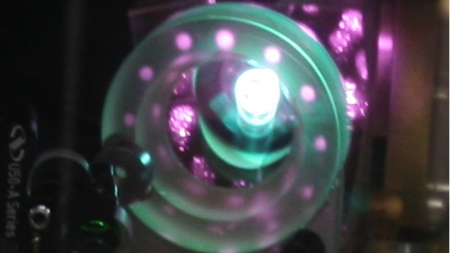
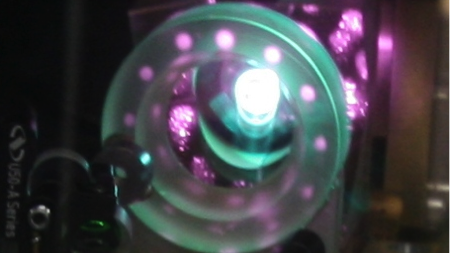
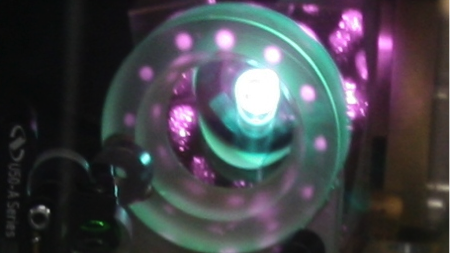
It was about 50 years ago, at the very beginning of laser physics, that scientists realized the tremendous potential of this source for generating ultrashort light pulses with unique properties and applications. Scientists and engineers invented the different concepts of Q-switching and mode-locking, and already in 1970, pulses with picosecond durations have been demonstrated from dye lasers. In the late eighties the impressive road of success of solid-state laser materials started (see figure), beginning with neodymium doped crystals, exploring the potential of chromium doped materials, and finally, in the early two-thousands, the pulses emitted from Ti:sapphire oscillators reached durations close to the single optical cycle. Meanwhile, a whole bunch of different broad-band solid-state laser materials have been explored, covering the range from the near UV to the near infrared. Still, the most prominent laser material for the generation of femtosecond pulses in the few-cycle range is Ti:sapphire, because of the large gain bandwidth, the large heat conductivity, and the reliably available high crystal quality. Regarding to high power laser light generation, Yb doped materials became the most important gain media due to the availability of high brightness semiconductor pump lasers and due to the small quantum defect.
-
Two-crystal laser with cavity dumping
For many years our group is conducting research at the leading edge of cavity-dumped laser systems. For further power scaling of these systems we built up a two-crystal laser with cavity dumping working in the chirped pulse regime. By splitting the applied pump power to two gain media, we avoid the limitations of thermal lensing and opto-thermal damage of the crystals. In addition, the enhancement of the small-signal gain results in very high dumping efficiencies up to 67%. Thereby we achieve 7 µJ of pulse energy at a repetition rate of 1 MHz corresponding to 12 MW compressed peak power, which is sufficient for direct white light generation in YAG. Even higher output powers are obtained by using this laser system as a seed for a rod-type fiber amplifier.
![]()
![]()
![]()
-
Thin Disk Laser
Our group has outstanding theoretical and experimental experiences with thin disk lasers. More than 3 µJ have been reported from a passively mode-locked oscillator based on a Yb:KYW oscillator with cavity dumping at 1 MHz repetition rate and pulse durations below 700 fs. At even higher repetition rates of 34 MHz output powers up to 25 W with 440 fs duration are generated with a passively mode-locked Yb:KLuW thin disk oscillator. The frequency doubled output of the latter system is used as pump source for an optical parametric oscillator.
-
Few-cycle Ti:sapphire Oscillators
The development, characterization and application of few-cycle laser pulses generated by Ti:sapphire laser oscillators has been a mainstay of the group of Uwe Morgner for years.
The leading-edge lasers engineered by our group hold the distinction of generating the shortest pulse durations ever generated directly from an femtosecond oscillator as short as 4.3 fs, as well as the most energetic laser pulses recently achieved from Ti:sapphire lasers. By using broadband pulse shaping techniques and a stabilization of the electric field oscillation of those ultra-short laser pulses, arbitrary waveforms can be generated on a single-cycle scale that allows us to investigate numerous areas in fundamental physics with exceptional precision.
-
Thin Disk Regenerative Amplifier
A thin disk regenerative amplifier is built up for OPCPA pumping. The amplifier is seeded with the infrared edge of a broadband Ti:sapphire (link) oscillator without using any stretcher and compressor arrangements. Thus, the amplified output is optically synchronized with the Ti:sapphire output. This in combination with the obtained output energies of more than 100 µJ, pulse durations of about 1.5 ps and high repetition rates between 100 and 500 kHz makes the system an ideal pump source for parametric amplifiers.
Fiber Oscillators and Amplifiers
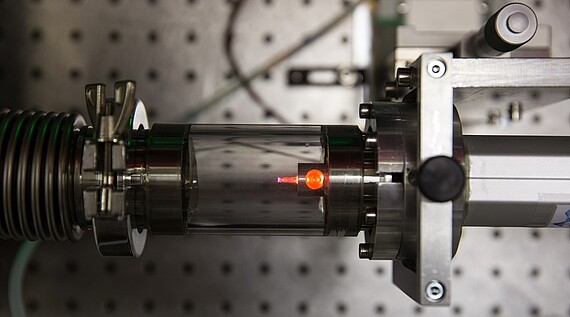
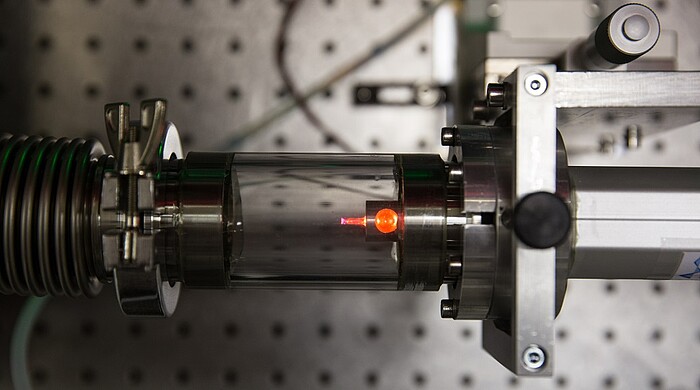
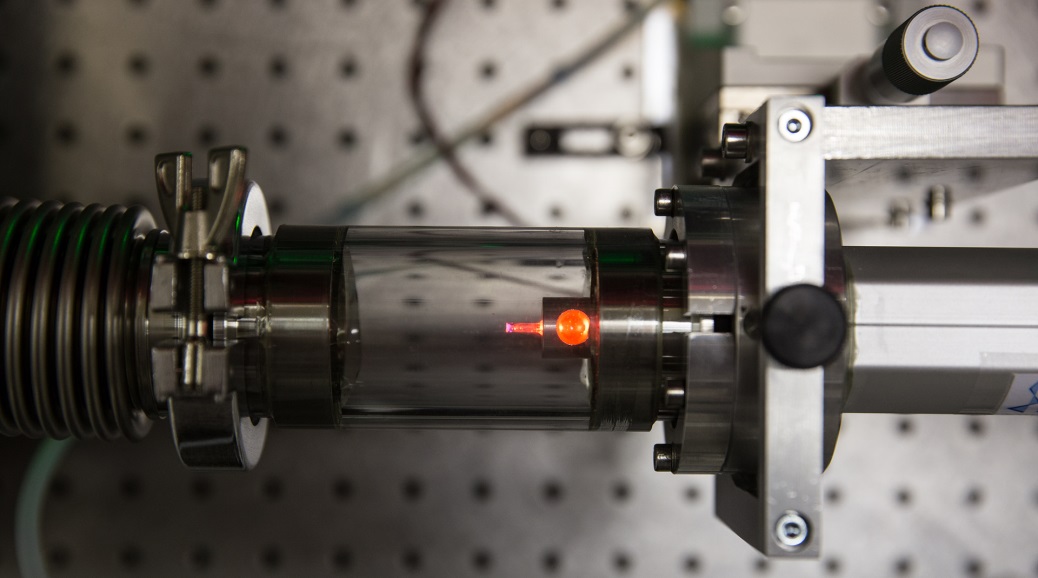
Based on wave guiding effects ultrafast fiber lasers offer a high potential for very stable and compact laser sources.
-
Ultrafast fiber oscillators
Based on wave guiding effects ultrafast fiber lasers offer a high potential for very stable and compact laser sources. Due to the design of the oscillator different pulse regimes can be realized allowing a scalability of the average output power by simultaneously reducing the pulse duration. By an optimization of the laser parameters we realized a fiber laser with a compressed pulse duration of 55 fs and 1 W output power. This system is developed as a pump laser for further systems as a non-collinear optical parametric oscillator.
![]()
![]()
![]()
-
Rod Type Fiber Amplifiers
As an alternative to the regenerative amplifier concept, the amplification by means of rod type fiber amplifiers is as well investigated in our group. For example using the two crystal oscillator as seed source (1 MHz, ~5 W, ~400 fs) amplified average powers of more than 100 W have been generated so far using an 80 cm long polarization maintaining fiber. The compression of those pulses leads to pulse energies of more than 80 µJ at 1 MHz repetition rate and pulse duration of about 700 fs. With this enormous peak power, the system is used in a PLD experiment to generate random lasing structures.
![]()
![]()
![]()
-
Hollow Fiber Propagation
Hollow core fiber pulse compression is a widely used technique to generate intense sub-10 fs laser pulses. Its high pulse intensity opened the gate to high-field physics studies with desktop experimental system. Nowadays, this technique was broadly used to obtained high-harmonic conversion and attosecond pulse generation. Comparing with other techniques, hollow core fiber pulse compression has excellent spatial beam quality and quite good energy transfer efficiency. Our 3m long flexible hollow core fiber platform can get sub-6fs laser pulse, and successfully applied in application research such as higher harmonic generation.
![]()
![]()
![]()





















